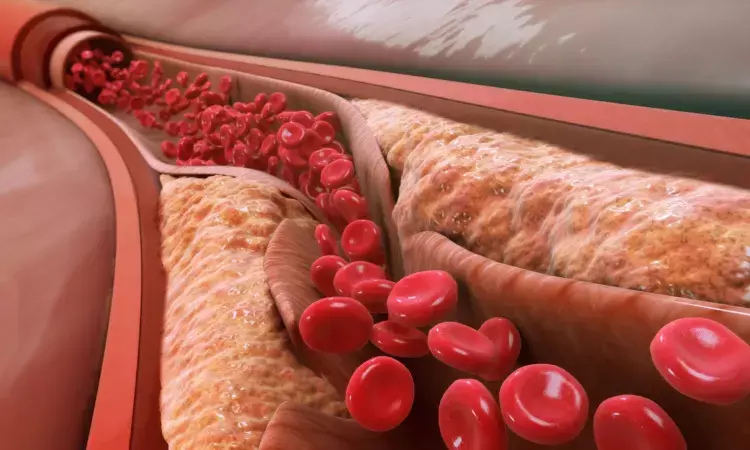- Home
- Medical news & Guidelines
- Anesthesiology
- Cardiology and CTVS
- Critical Care
- Dentistry
- Dermatology
- Diabetes and Endocrinology
- ENT
- Gastroenterology
- Medicine
- Nephrology
- Neurology
- Obstretics-Gynaecology
- Oncology
- Ophthalmology
- Orthopaedics
- Pediatrics-Neonatology
- Psychiatry
- Pulmonology
- Radiology
- Surgery
- Urology
- Laboratory Medicine
- Diet
- Nursing
- Paramedical
- Physiotherapy
- Health news
- Fact Check
- Bone Health Fact Check
- Brain Health Fact Check
- Cancer Related Fact Check
- Child Care Fact Check
- Dental and oral health fact check
- Diabetes and metabolic health fact check
- Diet and Nutrition Fact Check
- Eye and ENT Care Fact Check
- Fitness fact check
- Gut health fact check
- Heart health fact check
- Kidney health fact check
- Medical education fact check
- Men's health fact check
- Respiratory fact check
- Skin and hair care fact check
- Vaccine and Immunization fact check
- Women's health fact check
- AYUSH
- State News
- Andaman and Nicobar Islands
- Andhra Pradesh
- Arunachal Pradesh
- Assam
- Bihar
- Chandigarh
- Chattisgarh
- Dadra and Nagar Haveli
- Daman and Diu
- Delhi
- Goa
- Gujarat
- Haryana
- Himachal Pradesh
- Jammu & Kashmir
- Jharkhand
- Karnataka
- Kerala
- Ladakh
- Lakshadweep
- Madhya Pradesh
- Maharashtra
- Manipur
- Meghalaya
- Mizoram
- Nagaland
- Odisha
- Puducherry
- Punjab
- Rajasthan
- Sikkim
- Tamil Nadu
- Telangana
- Tripura
- Uttar Pradesh
- Uttrakhand
- West Bengal
- Medical Education
- Industry
Achieving very low LDL-C tied to lower risk of MI, stroke, and death with no safety concerns: FOURIER-OLE analysis

USA: Long-term achievement of lower LDL-C levels, down to <20 mg/dL, is associated with a reduced risk of cardiovascular (CV) outcomes and no safety concerns in patients with atherosclerotic cardiovascular disease, according to an analysis of FOURIER-OLE. The study appeared in the journal Circulation on Feb 13 2023.
LDL-C (low-density lipoprotein cholesterol) is a well-known risk factor for atherosclerotic cardiovascular disease. However, there is no information on the optimal achieved LDL-C level concerning safety and efficacy in the long term.
FOURIER (Further Cardiovascular Outcomes Research With PCSK9 Inhibition in Subjects With Elevated Risk) comprised 27 564 patients with stable atherosclerotic cardiovascular disease. They were randomized to evolocumab or placebo and followed for a median of 2.2 years. In FOURIER-OLE, the open-label extension, 6635 patients transitioned to open-label evolocumab irrespective of initial treatment allocation in the parent trial and were followed for an additional five years.
Prakriti Gaba from Brigham and Women's Hospital and Harvard Medical School in Boston, MA, and colleagues examined the relationship between achieved LDL-C levels, defined as an average of the first two measured LDL-C levels, in FOURIER-OLE (in 6559 patients) and the incidence of subsequent CV and safety outcomes. Sensitivity analyses were also performed to evaluate cardiovascular and safety effects in the whole FOURIER-OLE and FOURIER patient population.
The study led to the following findings:
· In FOURIER-OLE, 40%, 24%, 16%, 12%, and 7% patients achieved LDL-cholesterol levels of 20 to <40, <20, 40 to <55, ≥70, and 55 to <70 mg/dL, respectively.
· The team observed a monotonic relationship between lower achieved LDL-C levels—down to very low levels <20 mg/dL—and a lower risk of the primary efficacy endpoint (composite of myocardial infarction, cardiovascular death, stroke, or hospitalization for unstable angina or coronary revascularization) and the key secondary efficacy endpoint (composite of myocardial infarction, cardiovascular death, or stroke) that persisted after multivariable adjustment.
· No statistically significant associations were found between lower achieved levels of LDL-C and increased risk of the safety outcomes (new or recurrent cancer, serious adverse events, hemorrhagic stroke, cataract-related adverse events, neurocognitive adverse events, new-onset diabetes, muscle-related events, or noncardiovascular death) in the primary analyses.
· Similar findings were seen in the whole FOURIER-OLE and FOURIER cohort up to a maximum follow-up of 8.6 years.
To conclude, long-term achievement of lower LDL-cholesterol levels down to <20 mg/dL was linked with a lower risk of CV outcomes and no notable safety concerns in patients with cardiovascular disease.
Reference:
Gaba P, O'Donoghue ML, Park JG, Wiviott SD, Atar D, Kuder JF, Im K, Murphy SA, De Ferrari GM, Gaciong ZA, Toth K, Gouni-Berthold I, Lopez-Miranda J, Schiele F, Mach F, Flores-Arredondo JH, López JAG, Elliott-Davey M, Wang B, Monsalvo ML, Abbasi S, Giugliano RP, Sabatine MS. Association Between Achieved Low-Density Lipoprotein Cholesterol Levels and Long-Term Cardiovascular and Safety Outcomes: An Analysis of FOURIER-OLE. Circulation. 2023 Feb 13. doi: 10.1161/CIRCULATIONAHA.122.063399. Epub ahead of print. PMID: 36779348.
Dr Kamal Kant Kohli-MBBS, DTCD- a chest specialist with more than 30 years of practice and a flair for writing clinical articles, Dr Kamal Kant Kohli joined Medical Dialogues as a Chief Editor of Medical News. Besides writing articles, as an editor, he proofreads and verifies all the medical content published on Medical Dialogues including those coming from journals, studies,medical conferences,guidelines etc. Email: drkohli@medicaldialogues.in. Contact no. 011-43720751


